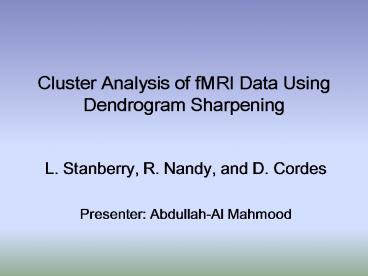Cluster Analysis of fMRI Data Using Dendrogram Sharpening PowerPoint PPT Presentation
1 / 28
Title: Cluster Analysis of fMRI Data Using Dendrogram Sharpening
1
Cluster Analysis of fMRI Data Using Dendrogram
Sharpening
- L. Stanberry, R. Nandy, and D. Cordes
- Presenter Abdullah-Al Mahmood
2
Outline
- Problem Definition
- The Solution
- Choice of methods, parameters etc.
- Algorithm Dendrogram Sharpening
- Experiments and Results
- Discussion
3
The Task
- Identify areas of activation in the brain in
response to certain stimuli
4
The Task
- Identify areas of activation in the brain in
response to certain stimuli - Simple case Single Stimulus
- Paced motor paradigm (finger tapping)
- Region of Interest Motor cortex (Motion
controlling area)
5
The Task
- Identify areas of activation in the brain in
response to certain stimuli - Simple case Single Stimulus
- Paced motor paradigm (finger tapping)
- Region of Interest Motor cortex (Motion
controlling area) - Challenges Noise Data Volume
6
Basic Algorithm
- Hierarchical clustering
7
Basic Algorithm
- Hierarchical clustering
- Factors to consider
- The (dis)similarity measure
- The linkage method
- Threshold for cutting tree vs. number of nodes
8
Distance Measure
- Two voxels are similar if the activation patterns
are similar - Correlation coefficient of the time courses
measures similarity - Distance between voxels i and j
- d(i, j ) 1 corr. coeff.(T (i ), T ( j ))
- Not a metric
9
Linkage Methods
- Single distance between closest pair of points
of two clusters - Average average distance of all pairs of
points, one from each cluster - Complete largest distance between two points in
two clusters - Single linkage is used in this work
10
Single Linkage Dendrogram (SLD)
- Pros
- Correctly identifies structure when clusters
overlap - Invariant under reordering of objects
- Computationally simple
- Cons
- Chaining effect highly dissimilar size of
children nodes
11
Dendrogram Example - I
12
Dendrogram Example - II
13
Dendrogram Sharpening
- Removes chaining effect and reveals interesting
structure - Discards some points in the process that are
attached to clusters later - Two parameters
- ncore for a node/cluster (large value)
- nfluff for its children (small value)
14
Dendrogram Sharpening
- The Basic Algorithm
- Form a queue of nodes (initially containing root
cluster only) - While not empty(queue) dequeue node
- If size(node) lt ncore discard all points under
it. - Else discard child(ren) with size lt nfluff and
queue the remaining child(ren).
15
Sharpening Example - I
16
Sharpening Example - II
17
Cluster Identification
- Method of inconsistent edges
- Measure of inconsistency
- Threshold Median 2(Upper-hinge value
Lower-hinge value) - Upper and lower values correspond to first and
third quartile values (ascending order sort for
distance)
18
Experimental Parameters
- Paradigm I
- 4 slices, each of 64?64 resolution, 750 time
points - Paradigm 2
- 20 slices, each of 64?64 resolution, 165 time
points - Activity and rest period alternated
19
Data reduction
- Discard voxels with SNR value ( mean signal
intensity ? standard deviation) in the first
decile - Discard voxels with correlation value below 0.5
(normalized series with mean 0 and std. dev. 1)
or having less than 5 significant correlations
20
Once Sharpened Data (P I)
21
Twice Sharpened Data (P I)
22
Final classification (P I)
23
Map from SPM analysis
24
A cluster from Paradigm II
25
Numerical Comparison
26
Discussion
- Dendrogram sharpening can help in identifying
clusters quite well - Can be applied to raw data as well as
preprocessed data - Not tested for weak/multiple stimuli
- Needs parameter tuning for sharpening algorithm
27
Reference
- L. Stanberry, R. Nandy and D. Cordes Cluster
Analysis of fMRI Data Using Dendrogram
Sharpening. Human Brain Mapping, 20201-219,
2003. - N.B. All figures and tables are taken from the
original work
28
Questions?

